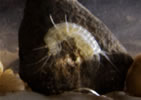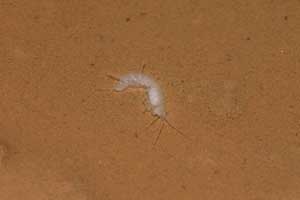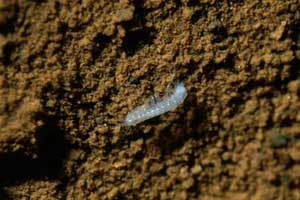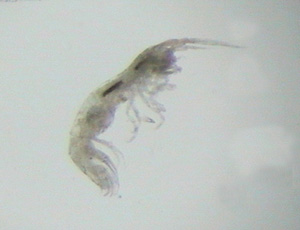 |
Cave Life of Devon |
 |
| |
| HOME |
| INTRODUCTION |
| LIFE IN THE ENTRANCE |
| LIFE IN THE CAVE |
| CONSERVATION |
| GLOSSARY |
| ACKNOWLEDGEMENTS |
| Bacteria |
| Fungi |
| Plants, Algae & Protozoans |
| Flatworms |
| Eelworms & Segmented Worms |
| Slugs & Snails |
| Crustacea |
| Insects |
| Spiders & Millipedes |
| Fish & Amphibians |
| Birds |
| Bats |
| Fossils |
| |
Crustaceans |
||||||||
There are many representatives of this phylum found underground, often in water; some of them are particularly ancient and found only in caves. Three types of Copepods have been identified in Devon caves. Paracyclops fimbriatus has been recorded from Baker’s and Pridhamsleigh Cavern; Acanthocyclops bisetosus has been identified from Tornewton Cave; and an unidentified Macrocyclops species has also been found in Pridhamsleigh Cavern. Because they are very small (about 1mm or less) and difficult to identify, their importance in the underground ecosystem is probably underestimated. Copepods are possibly the most widespread type of crustacean found in subterranean waters and an examination of most cave pools will often find tiny ‘specks’ moving about in the water and silt at the bottom. Woodlice are terrestrial Isopods. The Common Shiny Woodlouse, Oniscus asellus, is common and has been identified from several caves (e.g. Brixham Cavern, Haw Cave, Dart Garage Cave). Woodlice are usually near the thresholds of caves. One woodlouse, Androniscus dentiger, appears quite happy in the cave – it is a more delicate pink colour than the usual woodlouse and is frequently found under stones and in rotting piles of wood (and outside in your compost heap). It has been widely recorded from many caves in Devon.
The second species, Niphargus glenniei is Devon’s speciality. It was first discovered in Pridhamsleigh Cavern in 1948 and until 2000, Devon was the only place in the world from which it was recorded. In 2000 it was discovered in several wells in the west of Cornwall and it has since been recorded from wells in the east of the county and from Carnglaze Caverns, an underground slate mine near Liskeard. Niphargus glenniei is much smaller than N. aquilex (3-5mm) and in addition to wells and springs, it is known from fourteen caves in Devon (including Napp’s in the north) and four mines. There are particularly good populations, which appear to be permanent, in the gour pools in Easter Chamber (Reed’s) and Cascade Chamber (Afton) as well as in Penn Recca and Haytor Iron Mine. Niphargus species are omnivores, eating whatever source of food they can find, including dead animals, decaying plant matter and even ingesting silt to extract the micro-flora (fungi & bacteria) associated with it.
Recent work in Swildon’s Hole, on the Mendips, found specimens of the tiny troglobitic shrimp Microniphargus leruthi in the small streams of the North-west Stream Passage, Passchendaele and Black Hole Series. These are the first confirmed records of this species from Britain. It has subsequently also been identified from boreholes, wells and springs in Dorset, Gloucestershire, Isle of Wight and North Devon and was recently discovered, along with Niphargus glenniei in the sump in Sweetwater Pot, Berry Head. The species was discovered in two boreholes in Ireland in 2006 and subsequent work found it deep in riverine gravels and several caves in the Burren. Its next nearest occurrence is in the caves of the Ardennes in Belgium, Luxembourg and the upper Rhine basin in Germany. It was suspected that it might occur in Britain and had been overlooked in the past, due primarily to its small size (1.5 to 2mm). It looks like a tiny Crangonyx subterraneus.
The freshwater shrimp commonly seen outside is Gammarus pulex. It does get washed into caves and like many other creatures left in the dark they eventually turn white. They are rare in the pools fed by seepage water alone. They are scavengers, browsing on microscopic plants, animals, and decomposing material. Due to the lack of active stream passage in most Devon caves Gammarus is rarely recorded underground, although they have been recorded in Penn Recca mine. On the surface Gammarus are much more active at night than during the day hours. In active stream passage further north, where surface streams enter caves the washed in surface dwellers (e.g. Gammarus) seem to be able to out-compete the troglobites (e.g. Niphargus), so the troglobites are often found either deep in the cave or away from areas where their competitors might be e.g. in seepage areas rather than streams. So the best place to look for true troglobites like Niphargus is in pools and streams fed by seepage (often above the flood zone) and not the larger surface fed streams. Stalagmite flows and gour pools are a good place to look.
|
.jpg)


